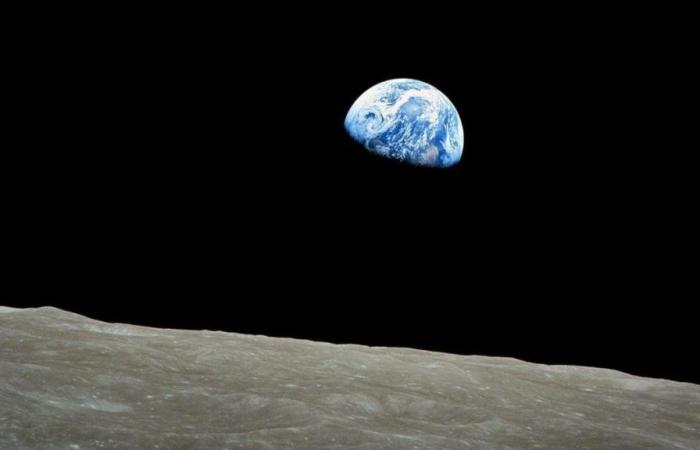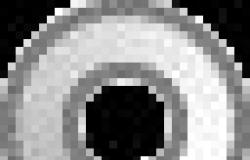It is overwhelming to think of the loneliness that prevails on the far side of the Moon. Whoever lived there could spend their entire life without knowing that very close there is a blue and living planet, aquatic and bright, because the Earth cannot be seen from there.
All observable objects show us their two sides, except the Moon. Our radio signals do not reach its dark side and its silence and isolation are a strange singularity.
None of our radio or television broadcasts touch it, because the lunar mass blocks them. In the entire sphere of dozens of light years through which the news that the Earth is home to a technological civilization is spreading towards the galaxy, there is only one place where it would be impossible to find out about such a wonder: the half that the Moon hides, half of the star that, paradoxically, is closest to us.
Each American Apollo mission put two white men on the visible side and left a third circling the Moon inside the ship. These last astronauts were isolated from the rest of humanity for almost 30 minutes in each orbit: Collins, Gordon, Roosa, Worden, Mattingly, Evans… Transitional Robinsons, the only people in history who can say, yes, that they have been alone.
The radioelectric silence on the far side of the Moon makes that place a good candidate for installing interference-free radio telescopes. But no one in the past considered the possibility of landing there. Of course, no astronauts have gone, but even sending an automatic probe would be useless because it would be impossible to send data or communicate with Earth from those places.
Chinese flag
Everything changed when China sent the Cháng’é 4 and 6 space missions to the far side of the Moon. The first landed there in January 2019 and deployed an all-terrain vehicle, while the second, which has just arrived, will be able to bring soil samples back to earth from the mysterious South Pole Aitken basin.
Before the arrival of Cháng’é 6, the Chinese space agency had to place repeater satellites that would allow communication, located somewhat beyond the Moon, the Quèquiáo relays 1 and 2. The amazing solution has made the hidden side of the Luna is no longer a place free of artificial waves. Humanity has already brought the noise. Garbage will soon follow.
The Moon, in the half that we see, has a face painted on it, those dark spots that draw the seas. The other half of her & mldr; What will the other half be like?
The distant Moon, the dark Moon, became an enigma when the telescope revealed that everything rotates in the cosmos. If everything is spinning, how is it possible that the moon’s silver ball doesn’t do the same? If our natural satellite rotated, seen from Earth, the panorama of its disk would change over time, and it does not. Something very strange was happening.
The reason for his hidden face
The explanation was provided by celestial mechanics. Just as the Moon exerts tides on the Earth that raise the seas, our planet acts on the lunar sphere, and does so with much more intense tides. So much so that, over time, the Earth’s tides have elongated the Moon in the direction of the Earth and have forced it to rotate around its axis in the same time it takes to complete an orbit around our planet. It is not that the Moon does not rotate, it does rotate, what happens is that it does so at the same time as its orbital rotation. As a result of this synchronous rotation, from Earth we only see one side of the Moon, frozen, with no apparent rotation. Correspondingly, on the other side there is an entire invisible hemisphere, the hidden side of the Moon.
All objects in the observable cosmos, without exception, show us their two sides over time. From the tiniest asteroid to the Sun, from the most remote galaxy to an extrasolar planet around Proxima Centauri, everything yira, yira so that, if you wait long enough and have a sufficiently powerful telescope, in principle you would have access to all sides. But the indifference of the lunar world, which is deaf and dumb, has played this practical joke on us, courtesy of celestial mechanics: the closest star in the cosmos is, at the same time, the only one, but the only one truly, that allows us hides half of its secrets.
In principle there shouldn’t be anything special in that place. It is assumed that cosmic processes have been similar and, for centuries, it was considered that the hidden lunar side should resemble the visible one. But what greater sign of progress than flying beyond the Moon and discovering what it hid from all of humanity throughout history? That is what the Soviet Union proposed in 1959 when it sent a technological prodigy, the Luna 3 space probe, to map what had never been seen.
The Earth is to blame
Consternation spread: the hidden hemisphere of the Moon turned out to be very different from the visible one and almost completely lacks dark seas. There is no painted face on the other side. Of course, since October 1959 the city of Moscow has had a sea, the Mare Moscoviense, on the opposite side of the Moon, and several of the most striking features on that side still sport Soviet names, such as the large dark Tsiolkovski crater.
It is not entirely clear why the other side of the Moon is so different from the one we see, but all the explanations that are used attribute it to the influence of the Earth, an unusual inhabited planet that cannot be heard or seen from the Earth. dark side of the Moon.






